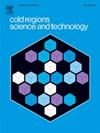地聚合物基高性能混凝土在低温和低温下的动力性能
IF 3.8
2区 工程技术
Q1 ENGINEERING, CIVIL
引用次数: 0
摘要
本研究探讨了地聚合物基超高性能混凝土(GUHPC)在极低温(- 160-20°C)和动态载荷耦合作用下的力学行为。该研究利用Φ100-mm拆分霍普金森压力棒(SHPB)技术进行动态测试。动态冲击实验在20、- 70和- 160℃的温度下进行,压缩试验的应变速率为40 ~ 160 s−1,劈裂拉伸试验的应变速率为20 ~ 80 s−1。结果表明:随着温度的降低和应变速率的增大,GUHPC的抗压强度和劈裂抗拉强度均增大;在低温和低温条件下,压缩系数(DIFfc)和拉伸系数(DIFft)的动态增加因子(DIF)均较高。与应变速率为160 s−1的20℃相比,- 70℃和- 160℃时的DIFfc′值分别高出约12%和22%。与室温下应变速率为40 s−1时相比,- 70℃和- 160℃时的温差分别增大了35%和47%。研究还考察了材料的微观结构变化、失效模式、能量吸收能力,并建立了预测不同温度下DIF的经验公式。x射线计算机断层扫描(CT)显示,在不同温度下,GUHPC的微观结构发生了明显的变化,显示出冰的形成、孔隙结构的改变和微开裂,尤其是在低温下。这些发现有助于理解极端环境下GUHPC的行为,并对其在受冲击载荷的低温结构中的应用具有重要意义。本文章由计算机程序翻译,如有差异,请以英文原文为准。
Dynamic behaviour of geopolymer-based ultra-high-performance concrete at low and cryogenic temperature
This study investigates the mechanical behaviour of geopolymer-based ultra-high performance concrete (GUHPC) under coupled extreme low temperatures (−160–20 °C) and dynamic loads. The research utilised a Φ100-mm split Hopkinson pressure bar (SHPB) technique for dynamic testing. Dynamic impact experiments were conducted at temperatures of 20, −70 and − 160 °C, with strain rates ranging from 40 to 160 s−1 for compression tests and 20 to 80 s−1 for splitting tensile tests. Results reveal that both compressive and splitting tensile strengths of GUHPC increase as temperature decreases and strain rate increases. The dynamic increase factor (DIF) for both compression () and tension () was found to be higher at low temperatures and cryogenic condition. The values at −70 °C and − 160 °C were approximately 12 % and 22 % higher, respectively, as compared to the values at 20 °C with the strain rate of 160 s−1. The at −70 °C and − 160 °C were 35 % and 47 % higher, respectively, in comparison with the room temperature values at a strain rate of 40 s−1. The study also examined the material microstructural change, failure modes, energy absorption capacity, and developed empirical formulae for predicting the DIF at various temperatures. X-ray computed tomography (CT) scans revealed distinct microstructural changes in GUHPC under various temperatures, illustrating ice formation, pore structure alterations and microcracking, particularly at cryogenic temperatures. These findings contribute to the understanding of GUHPC behaviour in extreme environments and have implications for its application in cryogenic structures subjected to impact loading.
求助全文
通过发布文献求助,成功后即可免费获取论文全文。
去求助
来源期刊

Cold Regions Science and Technology
工程技术-地球科学综合
CiteScore
7.40
自引率
12.20%
发文量
209
审稿时长
4.9 months
期刊介绍:
Cold Regions Science and Technology is an international journal dealing with the science and technical problems of cold environments in both the polar regions and more temperate locations. It includes fundamental aspects of cryospheric sciences which have applications for cold regions problems as well as engineering topics which relate to the cryosphere.
Emphasis is given to applied science with broad coverage of the physical and mechanical aspects of ice (including glaciers and sea ice), snow and snow avalanches, ice-water systems, ice-bonded soils and permafrost.
Relevant aspects of Earth science, materials science, offshore and river ice engineering are also of primary interest. These include icing of ships and structures as well as trafficability in cold environments. Technological advances for cold regions in research, development, and engineering practice are relevant to the journal. Theoretical papers must include a detailed discussion of the potential application of the theory to address cold regions problems. The journal serves a wide range of specialists, providing a medium for interdisciplinary communication and a convenient source of reference.
 求助内容:
求助内容: 应助结果提醒方式:
应助结果提醒方式:


